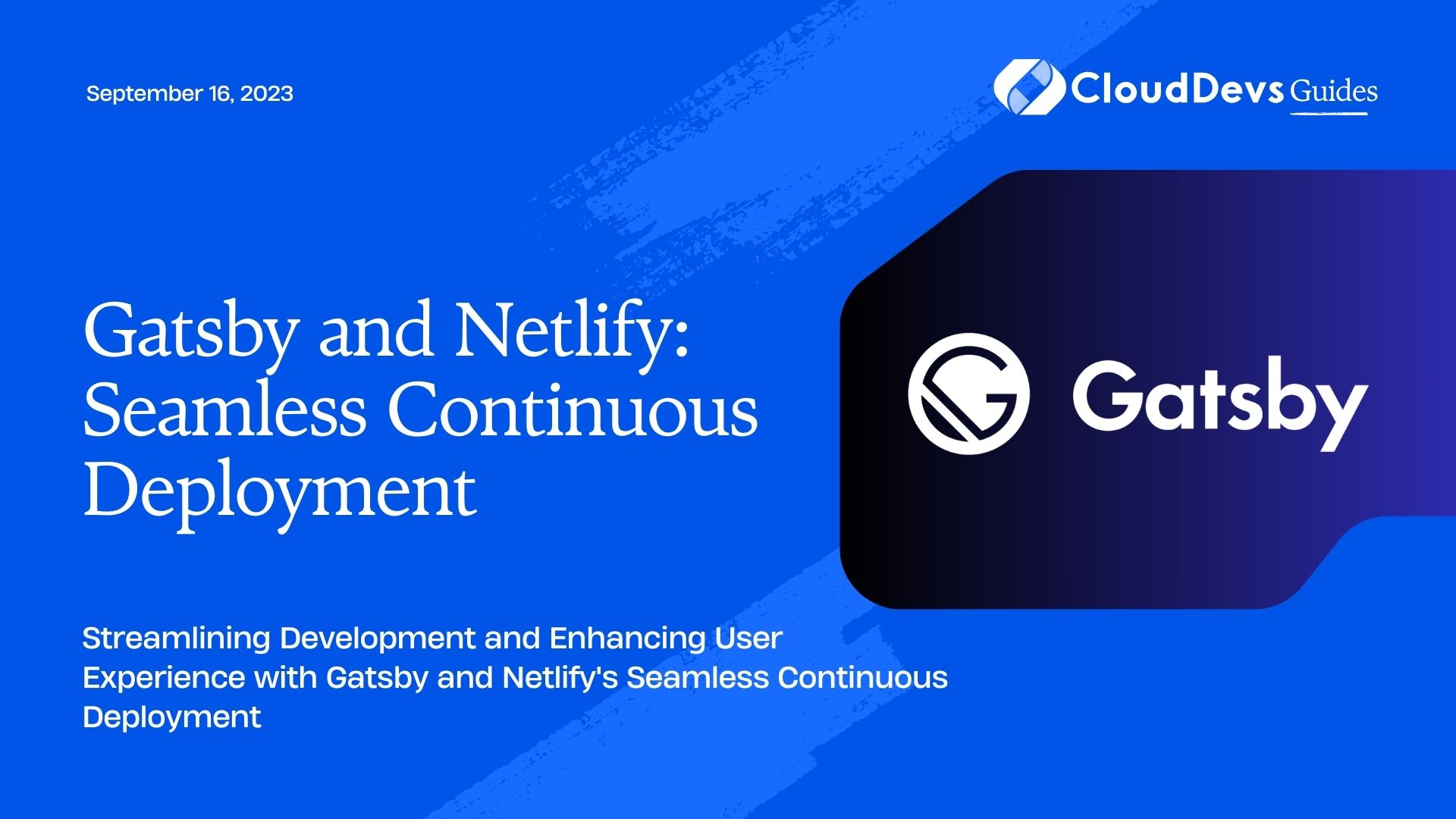Gatsby and Netlify: Seamless Continuous Deployment
In the fast-paced world of web development, ensuring your websites are efficient and always up-to-date is crucial to retaining users and staying ahead of the competition. To achieve this, developers need tools that streamline the development process and enable seamless continuous deployment. This is where Gatsby and Netlify come into the picture. In this blog, we will explore how Gatsby, a popular static site generator, and Netlify, a powerful hosting and deployment platform, work together to provide an unmatched continuous deployment experience.
1. What is Gatsby?
Gatsby is a modern static site generator that leverages React to build blazing-fast websites. It follows the Jamstack architecture, which stands for JavaScript, APIs, and Markup. Gatsby’s architecture allows developers to create dynamic websites by pulling data from APIs and rendering the content at build time. This eliminates the need for server-side rendering and enhances website performance and security.
2. Understanding Netlify:
Netlify is a powerful hosting platform and content delivery network (CDN) that complements Gatsby perfectly. It offers a wide range of features, including continuous deployment, automatic builds, and easy scaling. With Netlify, developers can host their static websites and web applications effortlessly, and it seamlessly integrates with various version control systems like Git.
3. The Power of Gatsby and Netlify Combined:
When Gatsby and Netlify are used together, they create a robust development environment that empowers developers to work efficiently and deliver high-quality websites to users. Let’s explore the key benefits of this powerful combination:
3.1. Instant Continuous Deployment:
One of the most significant advantages of using Gatsby with Netlify is the ability to achieve instant continuous deployment. Netlify automatically triggers a build process whenever changes are pushed to the repository. This means that as soon as developers commit their code, the website is rebuilt and updated, ensuring the latest version is always available to users.
3.2. Previews and Testing:
Netlify provides a preview functionality that allows developers to see changes in a live environment before merging them into the main branch. This is incredibly useful for testing new features, ensuring they work as expected before making them publicly available.
3.3. Performance Optimization:
Both Gatsby and Netlify are designed with performance in mind. Gatsby generates static HTML files that are highly optimized, resulting in faster load times and better SEO rankings. Netlify’s CDN ensures that these optimized files are distributed globally, reducing latency and delivering content to users from the nearest server.
3.4. Scalability and Security:
Netlify handles the scalability of your websites effortlessly. As your user base grows, Netlify automatically scales to handle increased traffic, ensuring your website remains performant. Additionally, the static nature of Gatsby sites reduces the attack surface, making them inherently more secure compared to traditional dynamic websites.
4. Seamless Integration Process:
Integrating Gatsby with Netlify is a straightforward process that requires minimal effort. Let’s walk through the steps to set up your project for seamless continuous deployment:
4.1. Create a Gatsby Project:
If you haven’t already, you can initiate a new Gatsby project using the Gatsby CLI. Open your terminal and run the following command:
bash gatsby new my-gatsby-project
This will set up a new Gatsby project in a folder named “my-gatsby-project.”
4.2. Set Up Version Control:
Initialize a new Git repository in your Gatsby project directory:
bash cd my-gatsby-project git init
Next, create a .gitignore file and add the following lines to exclude unnecessary files from version control:
plaintext node_modules/ .cache/ public/
4.3. Connect to Netlify:
Go to the Netlify website (https://www.netlify.com/) and sign up for an account if you don’t have one already. Once you’re logged in, click the “New site from Git” button, select your Git provider, and authorize Netlify to access your repository.
4.4. Configure Build Settings:
After connecting your repository, Netlify will automatically detect your Gatsby project and suggest some basic build settings. Ensure that the “Build command” is set to:
plaintext npm run build
And the “Publish directory” is set to:
plaintext public/
These settings tell Netlify how to build and publish your Gatsby site.
4.5. Deploy Your Site:
With the build settings configured, simply click the “Deploy site” button in Netlify, and it will start the deployment process. Once the build is complete, Netlify will provide you with a unique URL where your site is live.
5. Advanced Netlify Features:
Beyond the basics of continuous deployment, Netlify offers some advanced features that enhance the development and deployment experience even further:
5.1. Custom Domains:
Netlify allows you to set up custom domains for your websites easily. This helps establish a strong brand identity and makes it more convenient for users to access your site.
5.2. Environment Variables:
Managing environment-specific configurations is crucial in modern web development. Netlify allows you to define environment variables through its user interface or directly in your repository settings.
5.3. Serverless Functions:
Netlify enables you to create serverless functions, which are small pieces of backend logic that can be invoked via HTTP requests. This allows you to build dynamic features without managing a traditional server.
Conclusion
Gatsby and Netlify form a powerful duo that simplifies the continuous deployment process for web developers. With Gatsby’s fast and efficient static site generation and Netlify’s seamless hosting and deployment capabilities, developers can focus on building great websites without worrying about complex infrastructure. By using this combination, you can ensure that your websites are always up-to-date, highly performant, and provide an excellent user experience.
Start leveraging the power of Gatsby and Netlify today and witness the seamless continuous deployment experience yourself!
Table of Contents






